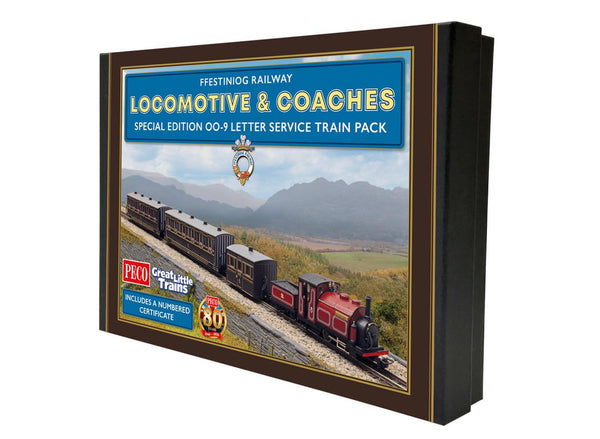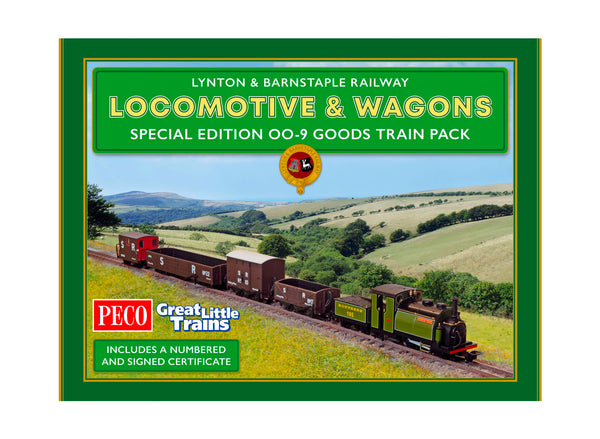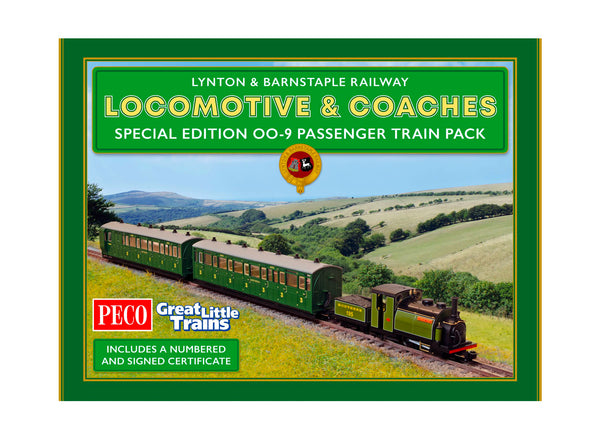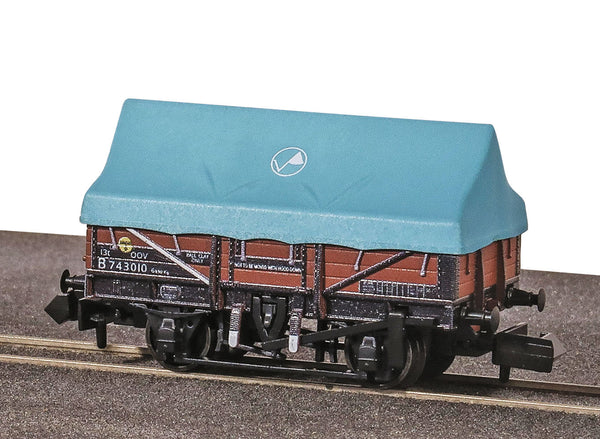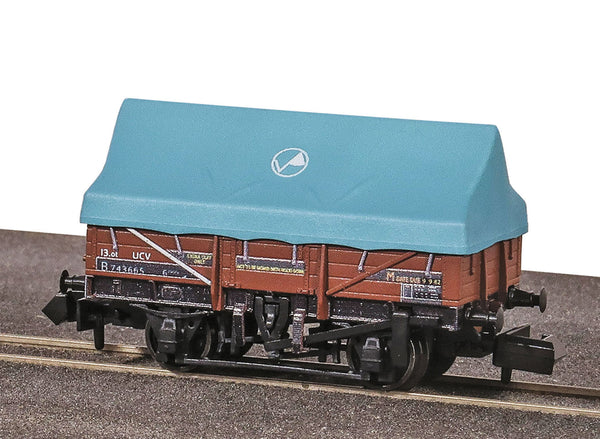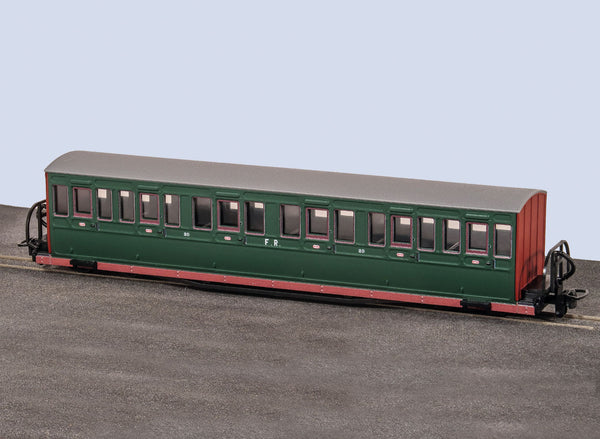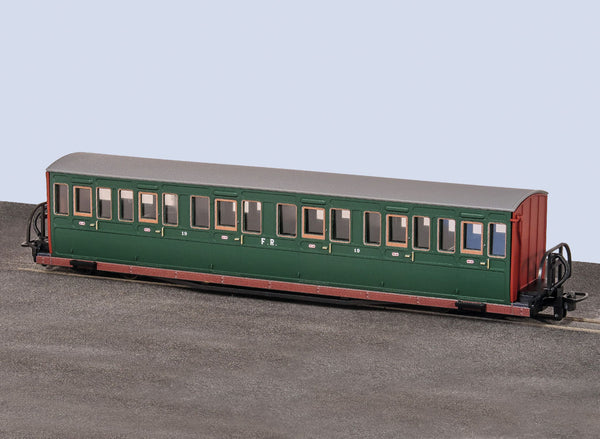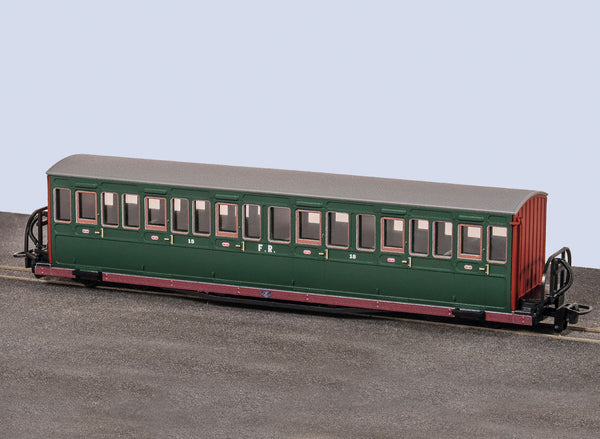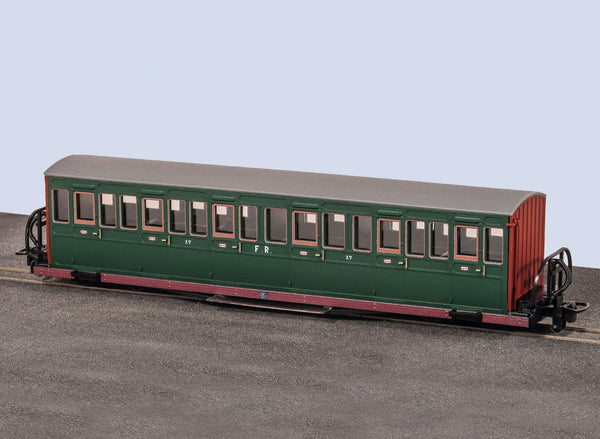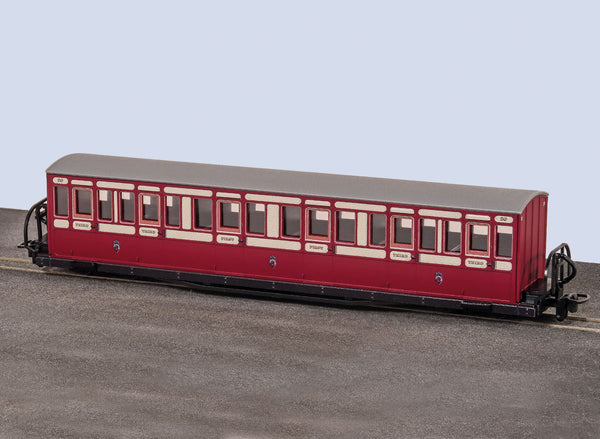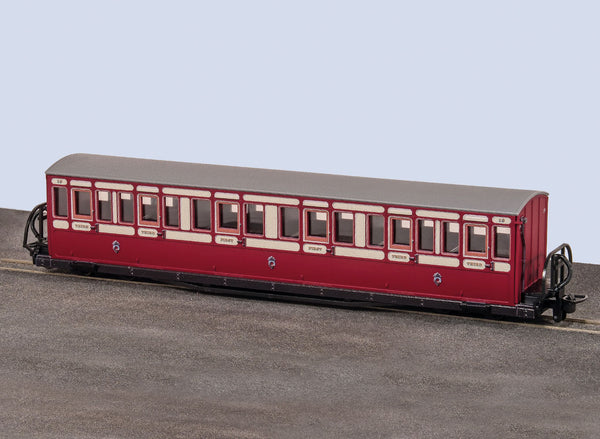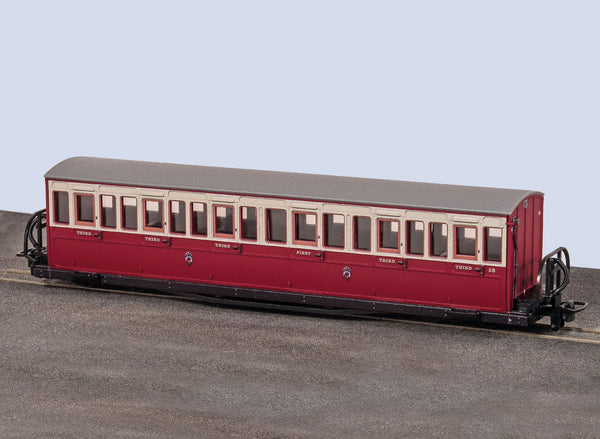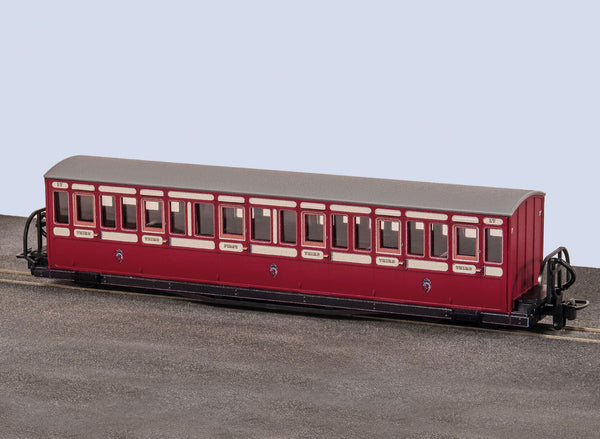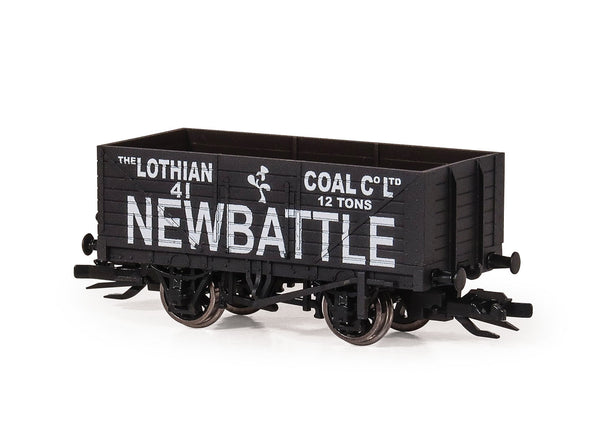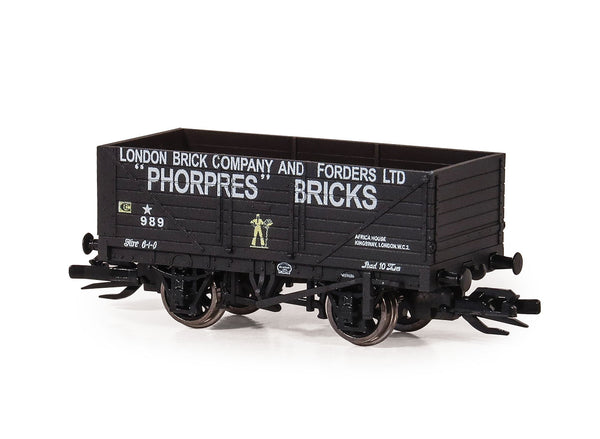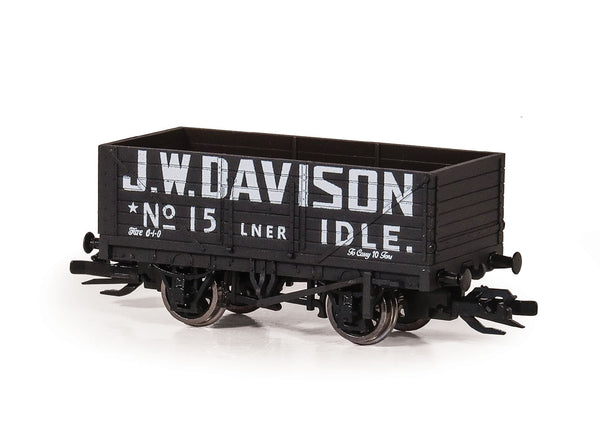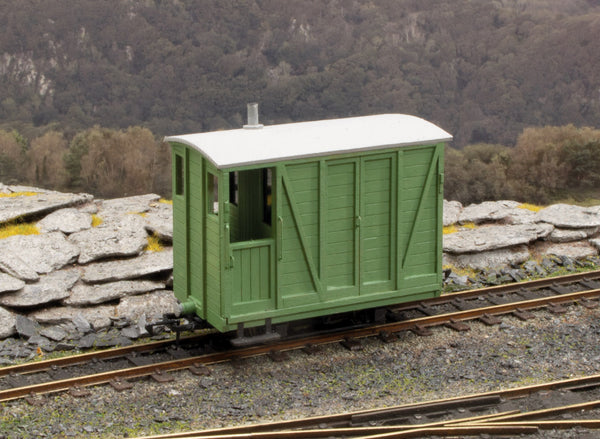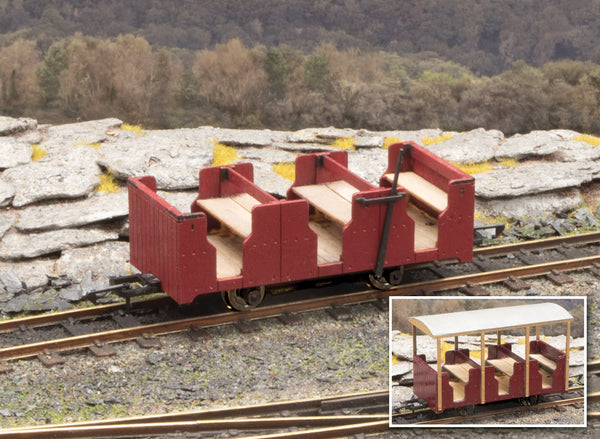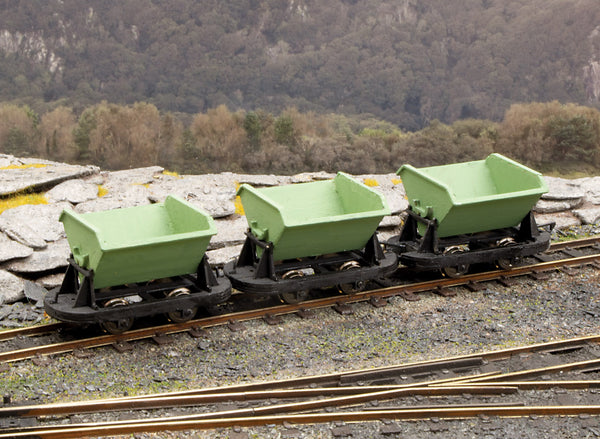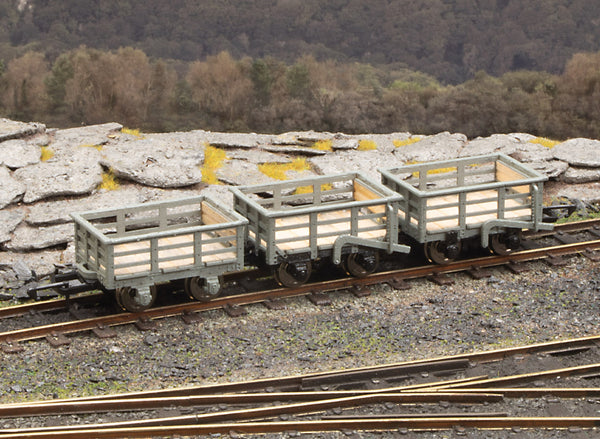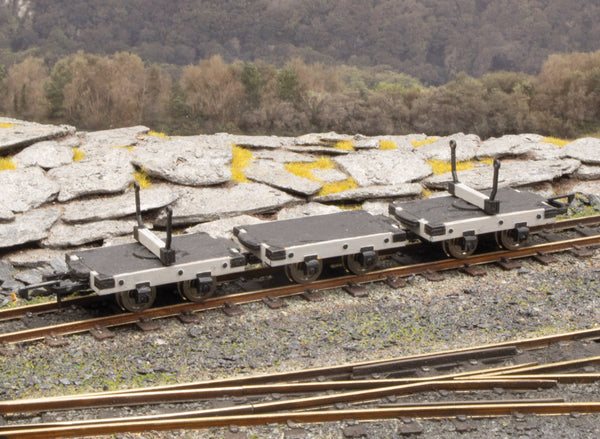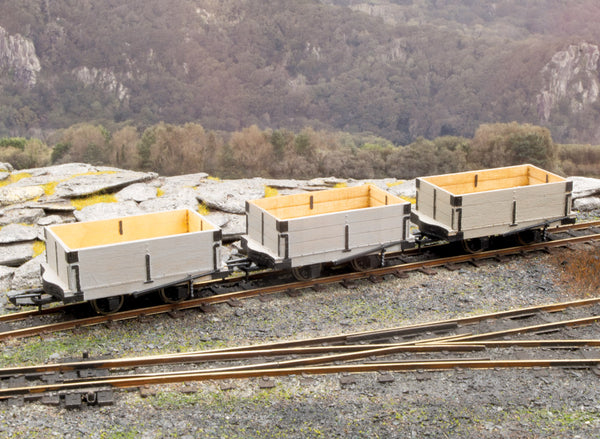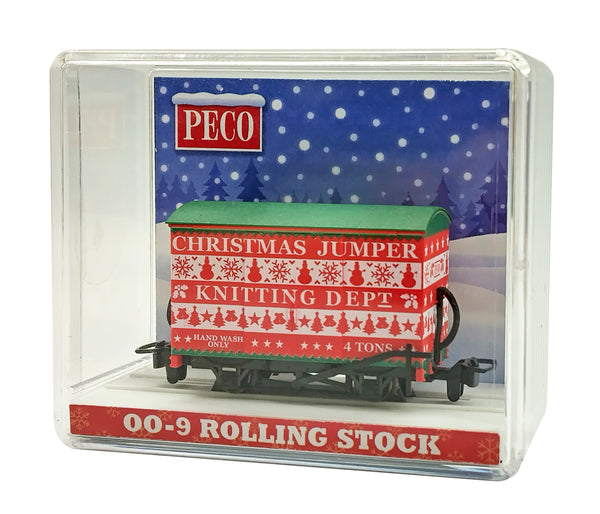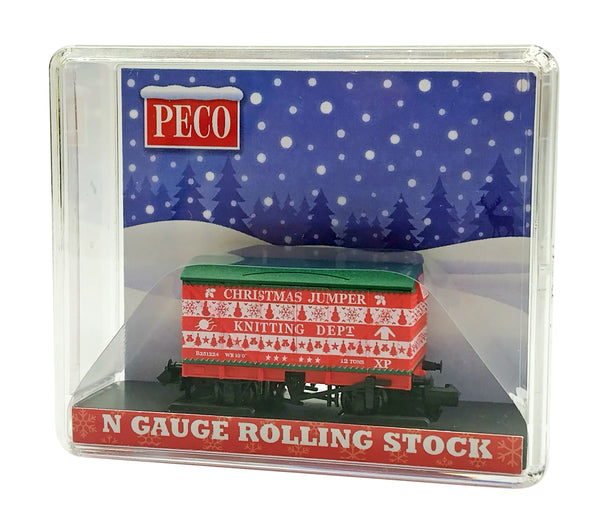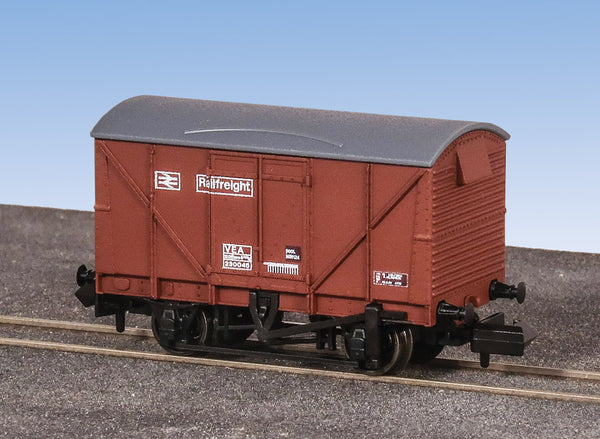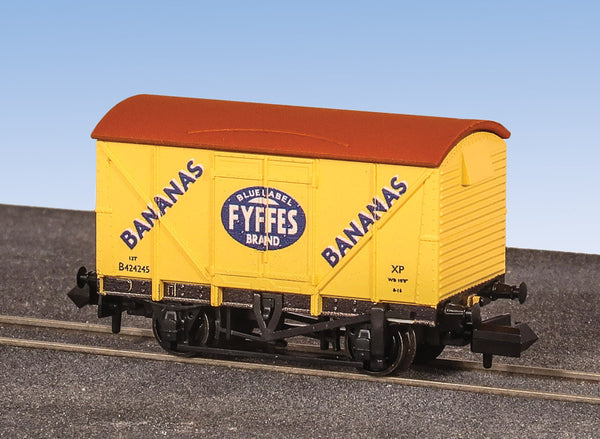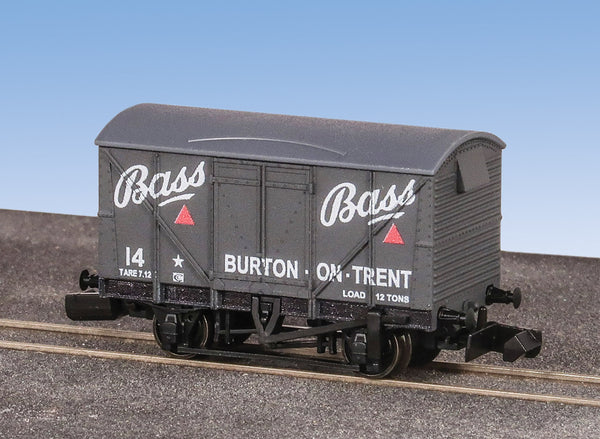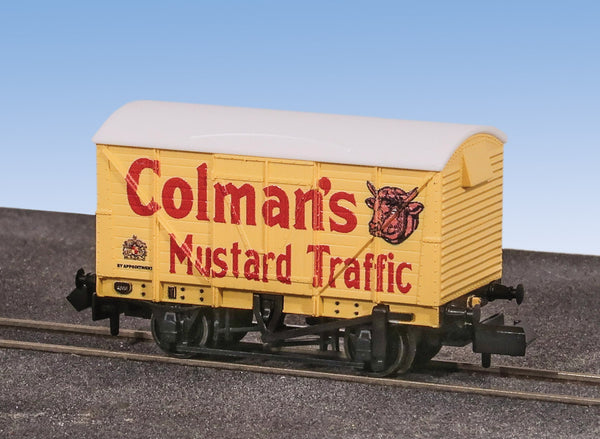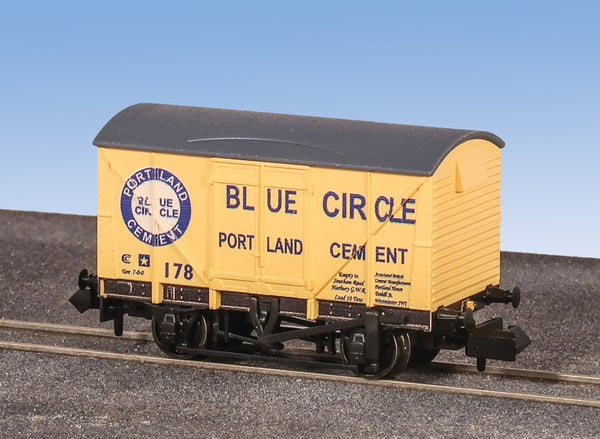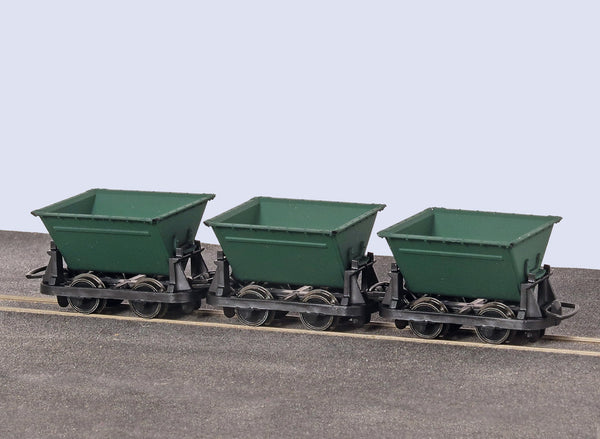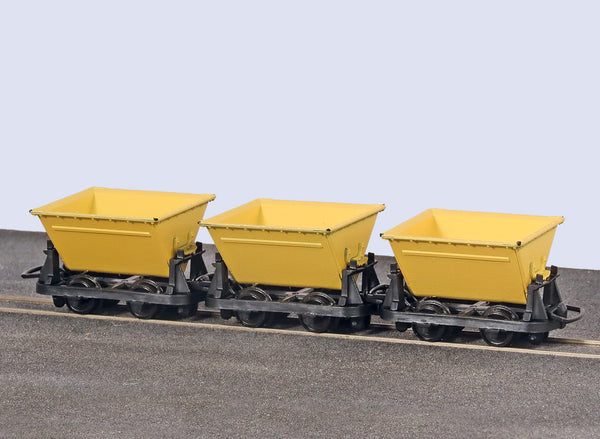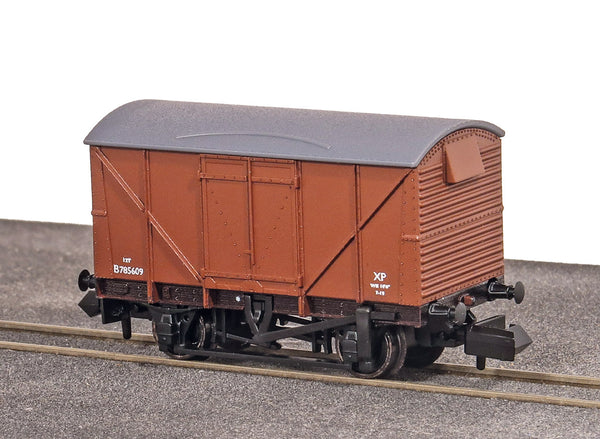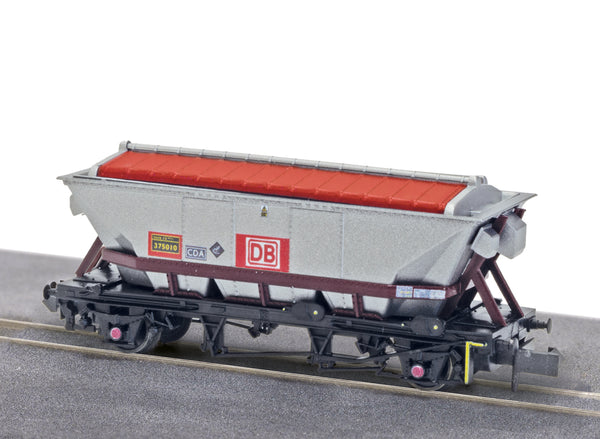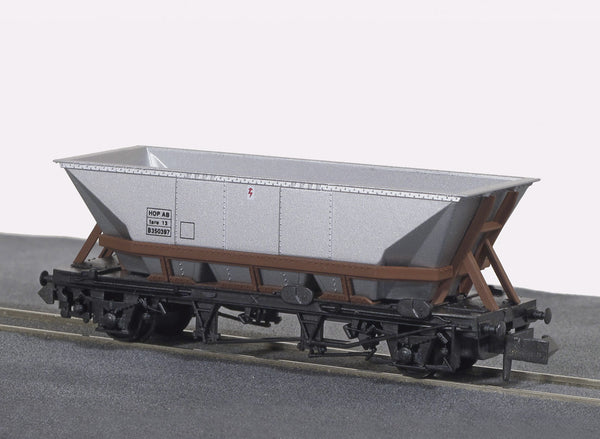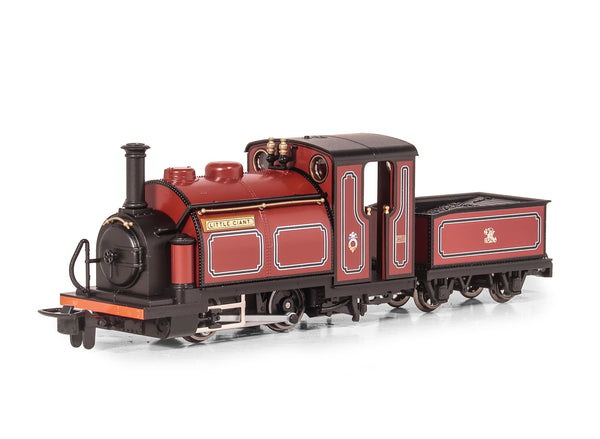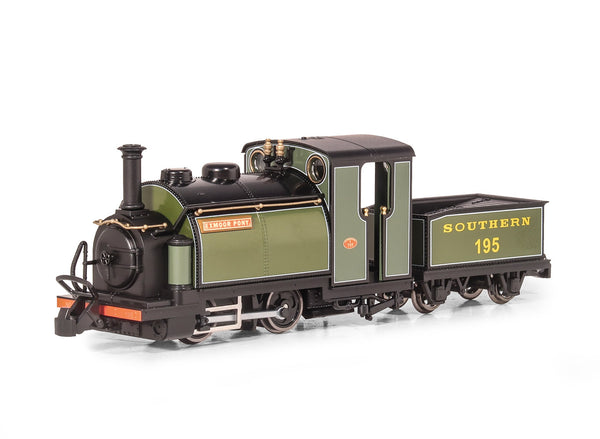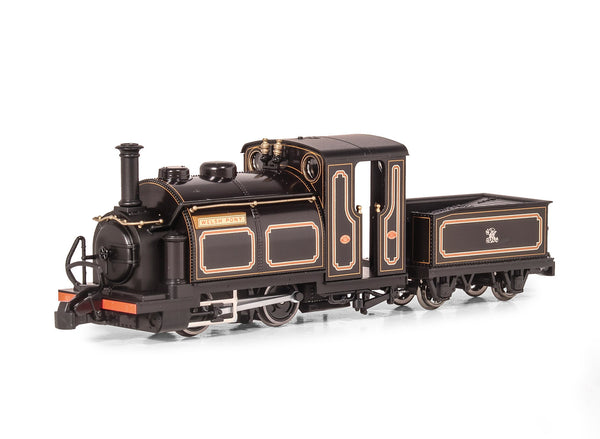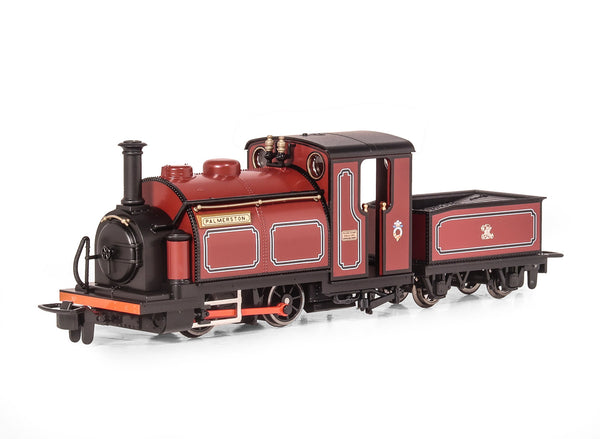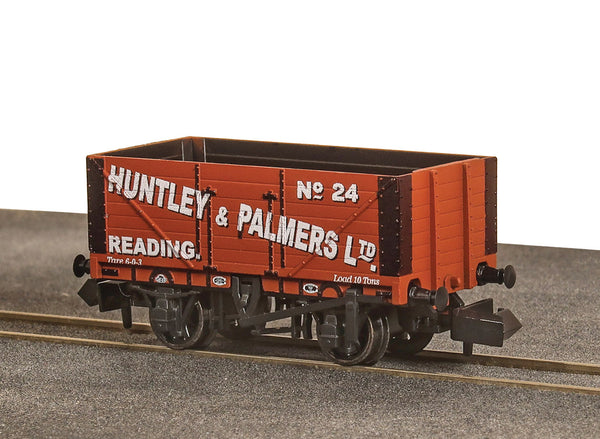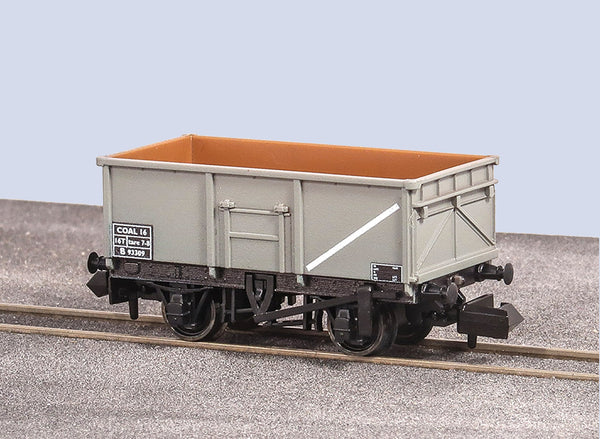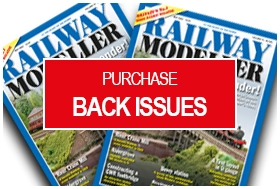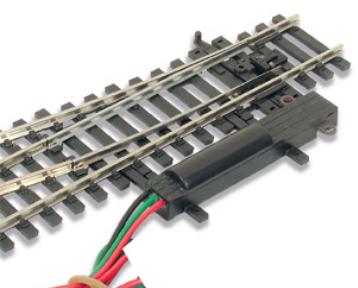DURCHSUCHEN SIE PECO-PRODUKTE
Stöbern Sie durch unser komplettes Produktportfolio.
388 Products Found
Special Edition OO-9 Letter Service Train Pack (Ffestiniog Railway)
Alle Eisenbahnunternehmen verfügten über einen eigenen Bestand an Fahrzeugen für den Transport von Gütern und Gütern innerhalb ihres Streckennetzes und bei Bedarf auch auf die Strecken anderer Unternehmen. Diese wurden bei der Verstaatlichung in die British Railways integriert; Einige von ihnen sollten im Zuge der Sektorisierung noch einmal neu gestaltet werden, da das Netzwerk darauf vorbereitet war, wieder in Privatbesitz überzugehen. Alle Peco-Wagen verfügen über freilaufende Räder mit Steckachsen. Die ELC-Kupplung ist zwar mit den Standard-N-Spur-Kupplungen kompatibel, sorgt jedoch für einen realistischen Abstand zwischen den Fahrzeugen und ermöglicht die Verwendung des elektromagnetischen Entkopplers PL-25 zum Fernabkuppeln.
Special Edition OO-9 Press Train Pack (Welsh Highland Railway)
Alle Eisenbahnunternehmen verfügten über einen eigenen Bestand an Fahrzeugen für den Transport von Gütern und Gütern innerhalb ihres Streckennetzes und bei Bedarf auch auf die Strecken anderer Unternehmen. Diese wurden bei der Verstaatlichung in die British Railways integriert; Einige von ihnen sollten im Zuge der Sektorisierung noch einmal neu gestaltet werden, da das Netzwerk darauf vorbereitet war, wieder in Privatbesitz überzugehen. Alle Peco-Wagen verfügen über freilaufende Räder mit Steckachsen. Die ELC-Kupplung ist zwar mit den Standard-N-Spur-Kupplungen kompatibel, sorgt jedoch für einen realistischen Abstand zwischen den Fahrzeugen und ermöglicht die Verwendung des elektromagnetischen Entkopplers PL-25 zum Fernabkuppeln.
Special Edition OO-9 Goods Train Pack
Alle Eisenbahnunternehmen verfügten über einen eigenen Bestand an Fahrzeugen für den Transport von Gütern und Gütern innerhalb ihres Streckennetzes und bei Bedarf auch auf die Strecken anderer Unternehmen. Diese wurden bei der Verstaatlichung in die British Railways integriert; Einige von ihnen sollten im Zuge der Sektorisierung noch einmal neu gestaltet werden, da das Netzwerk darauf vorbereitet war, wieder in Privatbesitz überzugehen. Alle Peco-Wagen verfügen über freilaufende Räder mit Steckachsen. Die ELC-Kupplung ist zwar mit den Standard-N-Spur-Kupplungen kompatibel, sorgt jedoch für einen realistischen Abstand zwischen den Fahrzeugen und ermöglicht die Verwendung des elektromagnetischen Entkopplers PL-25 zum Fernabkuppeln.
Special Edition OO-9 Passenger Train Pack
Alle Eisenbahnunternehmen verfügten über einen eigenen Bestand an Fahrzeugen für den Transport von Gütern und Gütern innerhalb ihres Streckennetzes und bei Bedarf auch auf die Strecken anderer Unternehmen. Diese wurden bei der Verstaatlichung in die British Railways integriert; Einige von ihnen sollten im Zuge der Sektorisierung noch einmal neu gestaltet werden, da das Netzwerk darauf vorbereitet war, wieder in Privatbesitz überzugehen. Alle Peco-Wagen verfügen über freilaufende Räder mit Steckachsen. Die ELC-Kupplung ist zwar mit den Standard-N-Spur-Kupplungen kompatibel, sorgt jedoch für einen realistischen Abstand zwischen den Fahrzeugen und ermöglicht die Verwendung des elektromagnetischen Entkopplers PL-25 zum Fernabkuppeln.
NEW China Clay Hood Wagon, OOV B743010
Alle Eisenbahnunternehmen verfügten über einen eigenen Bestand an Fahrzeugen für den Transport von Gütern und Gütern innerhalb ihres Streckennetzes und bei Bedarf auch auf die Strecken anderer Unternehmen. Diese wurden bei der Verstaatlichung in die British Railways integriert; Einige von ihnen sollten im Zuge der Sektorisierung noch einmal neu gestaltet werden, da das Netzwerk darauf vorbereitet war, wieder in Privatbesitz überzugehen. Alle Peco-Wagen verfügen über freilaufende Räder mit Steckachsen. Die ELC-Kupplung ist zwar mit den Standard-N-Spur-Kupplungen kompatibel, sorgt jedoch für einen realistischen Abstand zwischen den Fahrzeugen und ermöglicht die Verwendung des elektromagnetischen Entkopplers PL-25 zum Fernabkuppeln.
NEW China Clay Hood Wagon, UCV B743470, Bauxite
Alle Eisenbahnunternehmen verfügten über einen eigenen Bestand an Fahrzeugen für den Transport von Gütern und Gütern innerhalb ihres Streckennetzes und bei Bedarf auch auf die Strecken anderer Unternehmen. Diese wurden bei der Verstaatlichung in die British Railways integriert; Einige von ihnen sollten im Zuge der Sektorisierung noch einmal neu gestaltet werden, da das Netzwerk darauf vorbereitet war, wieder in Privatbesitz überzugehen. Alle Peco-Wagen verfügen über freilaufende Räder mit Steckachsen. Die ELC-Kupplung ist zwar mit den Standard-N-Spur-Kupplungen kompatibel, sorgt jedoch für einen realistischen Abstand zwischen den Fahrzeugen und ermöglicht die Verwendung des elektromagnetischen Entkopplers PL-25 zum Fernabkuppeln.
NEW China Clay Hood Wagon, UCV B743665, Bauxite
Alle Eisenbahnunternehmen verfügten über einen eigenen Bestand an Fahrzeugen für den Transport von Gütern und Gütern innerhalb ihres Streckennetzes und bei Bedarf auch auf die Strecken anderer Unternehmen. Diese wurden bei der Verstaatlichung in die British Railways integriert; Einige von ihnen sollten im Zuge der Sektorisierung noch einmal neu gestaltet werden, da das Netzwerk darauf vorbereitet war, wieder in Privatbesitz überzugehen. Alle Peco-Wagen verfügen über freilaufende Räder mit Steckachsen. Die ELC-Kupplung ist zwar mit den Standard-N-Spur-Kupplungen kompatibel, sorgt jedoch für einen realistischen Abstand zwischen den Fahrzeugen und ermöglicht die Verwendung des elektromagnetischen Entkopplers PL-25 zum Fernabkuppeln.
FR Long 'Bowsider' Coach - Colonel Stephens No.20
The Ffestiniog Railway operated two pairs of bogie coaches numbered 17-20 and built by Brown Marshalls & Co and Gloucester Wagon Co. They were known as ‘Bowsiders’ because of the tumblehome shape of their sides. Numbers 17 and 18, built in 1876 are shorter with one 1st class compartment. Numbers 19 and 20, built in 1879 are longer with two 1st class compartments. All four are still in service on the Ffestiniog Railway today.
In the 1920s the elaborate liveries of the Victorian era were replaced with a simple scheme of green with red end panels. It became known as the ‘Colonel Stephens’ livery, after the General Manager of the Ffestiniog Railway from 1925 until his passing in 1931. The colour scheme was used until the end of passenger operations in 1939, sometimes alongside other colours such as yellow, in the mid 1930s.
Green with red ends was applied to carriage No.20 once again from 2005 until 2024, as depicted by GR-623B.
FR Long 'Bowsider' Coach - Colonel Stephens No.19
The Ffestiniog Railway operated two pairs of bogie coaches numbered 17-20 and built by Brown Marshalls & Co and Gloucester Wagon Co. They were known as ‘Bowsiders’ because of the tumblehome shape of their sides. Numbers 17 and 18, built in 1876 are shorter with one 1st class compartment. Numbers 19 and 20, built in 1879 are longer with two 1st class compartments. All four are still in service on the Ffestiniog Railway today.
In the 1920s the elaborate liveries of the Victorian era were replaced with a simple scheme of green with red end panels. It became known as the ‘Colonel Stephens’ livery, after the General Manager of the Ffestiniog Railway from 1925 until his passing in 1931. The colour scheme was used until the end of passenger operations in 1939, sometimes alongside other colours such as yellow, in the mid 1930s.
Green with red ends was applied to carriage No.20 once again from 2005 until 2024, as depicted by GR-623B.
FR Short 'Bowsider' Coach - Colonel Stephens No.18
The Ffestiniog Railway operated two pairs of bogie coaches numbered 17-20 and built by Brown Marshalls & Co and Gloucester Wagon Co. They were known as ‘Bowsiders’ because of the tumblehome shape of their sides. Numbers 17 and 18, built in 1876 are shorter with one 1st class compartment. Numbers 19 and 20, built in 1879 are longer with two 1st class compartments. All four are still in service on the Ffestiniog Railway today.
In the 1920s the elaborate liveries of the Victorian era were replaced with a simple scheme of green with red end panels. It became known as the ‘Colonel Stephens’ livery, after the General Manager of the Ffestiniog Railway from 1925 until his passing in 1931. The colour scheme was used until the end of passenger operations in 1939, sometimes alongside other colours such as yellow, in the mid 1930s.
Green with red ends was applied to carriage No.20 once again from 2005 until 2024, as depicted by GR-623B.
FR Short 'Bowsider' Coach - Colonel Stephens No.17
The Ffestiniog Railway operated two pairs of bogie coaches numbered 17-20 and built by Brown Marshalls & Co and Gloucester Wagon Co. They were known as ‘Bowsiders’ because of the tumblehome shape of their sides. Numbers 17 and 18, built in 1876 are shorter with one 1st class compartment. Numbers 19 and 20, built in 1879 are longer with two 1st class compartments. All four are still in service on the Ffestiniog Railway today.
In the 1920s the elaborate liveries of the Victorian era were replaced with a simple scheme of green with red end panels. It became known as the ‘Colonel Stephens’ livery, after the General Manager of the Ffestiniog Railway from 1925 until his passing in 1931. The colour scheme was used until the end of passenger operations in 1939, sometimes alongside other colours such as yellow, in the mid 1930s.
Green with red ends was applied to carriage No.20 once again from 2005 until 2024, as depicted by GR-623B.
FR Long 'Bowsider' Coach - Red & Cream No.20
The Ffestiniog Railway operated two pairs of bogie coaches numbered 17-20 and built by Brown Marshalls & Co and Gloucester Wagon Co. They were known as ‘Bowsiders’ because of the tumblehome shape of their sides. Numbers 17 and 18, built in 1876 are shorter with one 1st class compartment. Numbers 19 and 20, built in 1879 are longer with two 1st class compartments. All four are still in service on the Ffestiniog Railway today.
The red and cream livery was first applied to a rake of carriages in 1987 for the ‘Mountain Prince’ train service. Carriage 20 was the first Bowsider to appear in the livery.
Carriages 17 and 18 had cream applied to the full upper half of the carriage. 17 had the mouldings reinstated in 1990 as depicted by GR-602A. 18 continued to have cream across the upper half throughout its time in the scheme, as represented by GR-602B. Note the ‘Brown Marshalls & Co. Ltd’ builders plate printed on the ends of the carriage.
All four Bowsiders were repainted into historic liveries in the 2000s, but the red and cream colour scheme is still seen today on the more modern carriages
FR Long 'Bowsider' Coach - Red & Cream No.19
The Ffestiniog Railway operated two pairs of bogie coaches numbered 17-20 and built by Brown Marshalls & Co and Gloucester Wagon Co. They were known as ‘Bowsiders’ because of the tumblehome shape of their sides. Numbers 17 and 18, built in 1876 are shorter with one 1st class compartment. Numbers 19 and 20, built in 1879 are longer with two 1st class compartments. All four are still in service on the Ffestiniog Railway today.
The red and cream livery was first applied to a rake of carriages in 1987 for the ‘Mountain Prince’ train service. Carriage 20 was the first Bowsider to appear in the livery.
Carriages 17 and 18 had cream applied to the full upper half of the carriage. 17 had the mouldings reinstated in 1990 as depicted by GR-602A. 18 continued to have cream across the upper half throughout its time in the scheme, as represented by GR-602B. Note the ‘Brown Marshalls & Co. Ltd’ builders plate printed on the ends of the carriage.
All four Bowsiders were repainted into historic liveries in the 2000s, but the red and cream colour scheme is still seen today on the more modern carriages
FR Short 'Bowsider' Coach - Red & Cream No.18
The Ffestiniog Railway operated two pairs of bogie coaches numbered 17-20 and built by Brown Marshalls & Co and Gloucester Wagon Co. They were known as ‘Bowsiders’ because of the tumblehome shape of their sides. Numbers 17 and 18, built in 1876 are shorter with one 1st class compartment. Numbers 19 and 20, built in 1879 are longer with two 1st class compartments. All four are still in service on the Ffestiniog Railway today.
The red and cream livery was first applied to a rake of carriages in 1987 for the ‘Mountain Prince’ train service. Carriage 20 was the first Bowsider to appear in the livery.
Carriages 17 and 18 had cream applied to the full upper half of the carriage. 17 had the mouldings reinstated in 1990 as depicted by GR-602A. 18 continued to have cream across the upper half throughout its time in the scheme, as represented by GR-602B. Note the ‘Brown Marshalls & Co. Ltd’ builders plate printed on the ends of the carriage.
All four Bowsiders were repainted into historic liveries in the 2000s, but the red and cream colour scheme is still seen today on the more modern carriages
FR Short 'Bowsider' Coach - Red & Cream No.17
The Ffestiniog Railway operated two pairs of bogie coaches numbered 17-20 and built by Brown Marshalls & Co and Gloucester Wagon Co. They were known as ‘Bowsiders’ because of the tumblehome shape of their sides. Numbers 17 and 18, built in 1876 are shorter with one 1st class compartment. Numbers 19 and 20, built in 1879 are longer with two 1st class compartments. All four are still in service on the Ffestiniog Railway today.
The red and cream livery was first applied to a rake of carriages in 1987 for the ‘Mountain Prince’ train service. Carriage 20 was the first Bowsider to appear in the livery.
Carriages 17 and 18 had cream applied to the full upper half of the carriage. 17 had the mouldings reinstated in 1990 as depicted by GR-602A. 18 continued to have cream across the upper half throughout its time in the scheme, as represented by GR-602B. Note the ‘Brown Marshalls & Co. Ltd’ builders plate printed on the ends of the carriage.
All four Bowsiders were repainted into historic liveries in the 2000s, but the red and cream colour scheme is still seen today on the more modern carriages
TT:120 7-Plank Open Wagon, Newbattle
- Fine plastic moulding with thinner wagon body walls for accuracy.
- Interior detail as well as a high-level of exterior detail
- Separately-fitted brake lever.
- Brake shoes in line with the wheels
- Ultra-fine printing detail
- Free-running metal-tyred wheels
- Standard (removable) TT:120 coupler compatible with other TT:120 rolling stock on the market
TT:120 7-Plank Open Wagon, Phorpres Bricks
- Fine plastic moulding with thinner wagon body walls for accuracy.
- Interior detail as well as a high-level of exterior detail
- Separately-fitted brake lever.
- Brake shoes in line with the wheels
- Ultra-fine printing detail
- Free-running metal-tyred wheels
- Standard (removable) TT:120 coupler compatible with other TT:120 rolling stock on the market
TT:120 7-Plank Open Wagon, J. W. Davison
- Fine plastic moulding with thinner wagon body walls for accuracy.
- Interior detail as well as a high-level of exterior detail
- Separately-fitted brake lever.
- Brake shoes in line with the wheels
- Ultra-fine printing detail
- Free-running metal-tyred wheels
- Standard (removable) TT:120 coupler compatible with other TT:120 rolling stock on the market
4-Rad-Wagenfahrgestell
0–16,5 Coach-Teile zur individuellen Anpassung der OR-31- und OR-32 Coach-Bausätze; auch für Selbstbauprojekte.
4-Rad-Wagenfahrgestell
0–16,5 Coach-Teile zur individuellen Anpassung der OR-31- und OR-32 Coach-Bausätze; auch für Selbstbauprojekte.
4-Rad-Wagenfahrgestell
0–16,5 Coach-Teile zur individuellen Anpassung der OR-31- und OR-32 Coach-Bausätze; auch für Selbstbauprojekte.
4-Rad-Wagenfahrgestell
0–16,5 Coach-Teile zur individuellen Anpassung der OR-31- und OR-32 Coach-Bausätze; auch für Selbstbauprojekte.
4-Rad-Wagenfahrgestell
0–16,5 Coach-Teile zur individuellen Anpassung der OR-31- und OR-32 Coach-Bausätze; auch für Selbstbauprojekte.
4-Rad-Wagenfahrgestell
0–16,5 Coach-Teile zur individuellen Anpassung der OR-31- und OR-32 Coach-Bausätze; auch für Selbstbauprojekte.
OO-9 Bug Box Coach, Lackierung der 1970er/80er Jahre, Zoowagen
Unsere NEUEN „Bug Box“-Wagen der Ffestiniog Railway tragen die schlichte rote Lackierung aus der Denkmalschutzzeit der 1970er und 1980er Jahre. Sie mögen schlicht sein, aber wenn Sie genau hinschauen, werden Sie feststellen, dass es tatsächlich viele sehr feine Details gibt, darunter das FR-Emblem, die Türgriffe und die laufenden Nummern.
N Gauge 'Christmas Jumper Dept' Vanfit
Ganzzüge mit Spezialladungen sind ein Merkmal der modernen Eisenbahn. Alle Peco-Wagen verfügen über freilaufende Räder mit Steckachsen. Die ELC-Kupplung ist zwar mit den standardmäßigen N-Spur-Kupplungen kompatibel, hält jedoch einen realistischen Abstand zwischen Fahrzeugen und ermöglicht die Verwendung des elektromagnetischen Entkopplers PL-25 zum Fernentkuppeln.
BR Vanfit Wagon - Freight
Ganzzüge mit Spezialladungen sind ein Merkmal der modernen Eisenbahn. Alle Peco-Wagen verfügen über freilaufende Räder mit Steckachsen. Die ELC-Kupplung ist zwar mit den standardmäßigen N-Spur-Kupplungen kompatibel, hält jedoch einen realistischen Abstand zwischen Fahrzeugen und ermöglicht die Verwendung des elektromagnetischen Entkopplers PL-25 zum Fernentkuppeln.
BR Vanfit Wagon - Fyffes Bananas
Ganzzüge mit Spezialladungen sind ein Merkmal der modernen Eisenbahn. Alle Peco-Wagen verfügen über freilaufende Räder mit Steckachsen. Die ELC-Kupplung ist zwar mit den standardmäßigen N-Spur-Kupplungen kompatibel, hält jedoch einen realistischen Abstand zwischen Fahrzeugen und ermöglicht die Verwendung des elektromagnetischen Entkopplers PL-25 zum Fernentkuppeln.
BR Vanfit Wagon - Bass Brewery
Ganzzüge mit Spezialladungen sind ein Merkmal der modernen Eisenbahn. Alle Peco-Wagen verfügen über freilaufende Räder mit Steckachsen. Die ELC-Kupplung ist zwar mit den standardmäßigen N-Spur-Kupplungen kompatibel, hält jedoch einen realistischen Abstand zwischen Fahrzeugen und ermöglicht die Verwendung des elektromagnetischen Entkopplers PL-25 zum Fernentkuppeln.
BR Vanfit Wagon - Colman's Mustard
Ganzzüge mit Spezialladungen sind ein Merkmal der modernen Eisenbahn. Alle Peco-Wagen verfügen über freilaufende Räder mit Steckachsen. Die ELC-Kupplung ist zwar mit den standardmäßigen N-Spur-Kupplungen kompatibel, hält jedoch einen realistischen Abstand zwischen Fahrzeugen und ermöglicht die Verwendung des elektromagnetischen Entkopplers PL-25 zum Fernentkuppeln.
BR Vanfit Wagon - Blue Circle Cement
Ganzzüge mit Spezialladungen sind ein Merkmal der modernen Eisenbahn. Alle Peco-Wagen verfügen über freilaufende Räder mit Steckachsen. Die ELC-Kupplung ist zwar mit den standardmäßigen N-Spur-Kupplungen kompatibel, hält jedoch einen realistischen Abstand zwischen Fahrzeugen und ermöglicht die Verwendung des elektromagnetischen Entkopplers PL-25 zum Fernentkuppeln.
Hudson Rugga V-Skips (Green)
The familiar Rugga V-Skip 'tipping' wagon design was introduced in the 1930s - a development of the Robert Hudson company, based in Leeds. They could be supplied to the customer's specific requirements, with a skip size ranging from 13.5 to 54 cubic feet (0.38 to 1.53 cubic metres), and in most track gauges. The design allows the skip to tip in either direction, perfect for small industrial railways that needed to move and unload materials quickly and efficiently. The company even boasted that at any one time several thousand could be supplied from stock! These are supplied in an attractive display box of three.
Hudson Rugga V-Skips (Yellow)
The familiar Rugga V-Skip 'tipping' wagon design was introduced in the 1930s - a development of the Robert Hudson company, based in Leeds. They could be supplied to the customer's specific requirements, with a skip size ranging from 13.5 to 54 cubic feet (0.38 to 1.53 cubic metres), and in most track gauges. The design allows the skip to tip in either direction, perfect for small industrial railways that needed to move and unload materials quickly and efficiently. The company even boasted that at any one time several thousand could be supplied from stock! These are supplied in an attractive display box of three.
BR Vanfit, Plank Side
Ganzzüge mit Spezialladungen sind ein Merkmal der modernen Eisenbahn. Alle Peco-Wagen verfügen über freilaufende Räder mit Steckachsen. Die ELC-Kupplung ist zwar mit den standardmäßigen N-Spur-Kupplungen kompatibel, hält jedoch einen realistischen Abstand zwischen Fahrzeugen und ermöglicht die Verwendung des elektromagnetischen Entkopplers PL-25 zum Fernentkuppeln.
BR Vanfit, Plywood Side
Ganzzüge mit Spezialladungen sind ein Merkmal der modernen Eisenbahn. Alle Peco-Wagen verfügen über freilaufende Räder mit Steckachsen. Die ELC-Kupplung ist zwar mit den standardmäßigen N-Spur-Kupplungen kompatibel, hält jedoch einen realistischen Abstand zwischen Fahrzeugen und ermöglicht die Verwendung des elektromagnetischen Entkopplers PL-25 zum Fernentkuppeln.
BR 16t Mineral Wagon, Coal 16VB, Fitted, Bauxite
Ganzzüge mit Spezialladungen sind ein Merkmal der modernen Eisenbahn. Alle Peco-Wagen verfügen über freilaufende Räder mit Steckachsen. Die ELC-Kupplung ist zwar mit den standardmäßigen N-Spur-Kupplungen kompatibel, hält jedoch einen realistischen Abstand zwischen Fahrzeugen und ermöglicht die Verwendung des elektromagnetischen Entkopplers PL-25 zum Fernentkuppeln.
Ex-BR Iron Ore Tippler, NCB
Ganzzüge mit Spezialladungen sind ein Merkmal der modernen Eisenbahn. Alle Peco-Wagen verfügen über freilaufende Räder mit Steckachsen. Die ELC-Kupplung ist zwar mit den standardmäßigen N-Spur-Kupplungen kompatibel, hält jedoch einen realistischen Abstand zwischen Fahrzeugen und ermöglicht die Verwendung des elektromagnetischen Entkopplers PL-25 zum Fernentkuppeln.
Ex-BR 16t Mineral Wagon, NCB
Ganzzüge mit Spezialladungen sind ein Merkmal der modernen Eisenbahn. Alle Peco-Wagen verfügen über freilaufende Räder mit Steckachsen. Die ELC-Kupplung ist zwar mit den standardmäßigen N-Spur-Kupplungen kompatibel, hält jedoch einen realistischen Abstand zwischen Fahrzeugen und ermöglicht die Verwendung des elektromagnetischen Entkopplers PL-25 zum Fernentkuppeln.
BR 16t Mineral Wagon, Coal 16VB, Fitted, Bauxite
Ganzzüge mit Spezialladungen sind ein Merkmal der modernen Eisenbahn. Alle Peco-Wagen verfügen über freilaufende Räder mit Steckachsen. Die ELC-Kupplung ist zwar mit den standardmäßigen N-Spur-Kupplungen kompatibel, hält jedoch einen realistischen Abstand zwischen Fahrzeugen und ermöglicht die Verwendung des elektromagnetischen Entkopplers PL-25 zum Fernentkuppeln.
CDA - DB Cargo China Clay Hopper Wagon
Ganzzüge mit Spezialladungen sind ein Merkmal der modernen Eisenbahn. Alle Peco-Wagen verfügen über freilaufende Räder mit Steckachsen. Die ELC-Kupplung ist zwar mit den standardmäßigen N-Spur-Kupplungen kompatibel, hält jedoch einen realistischen Abstand zwischen Fahrzeugen und ermöglicht die Verwendung des elektromagnetischen Entkopplers PL-25 zum Fernentkuppeln.
Bierwagen Nr. 38622
Alle Eisenbahnunternehmen verfügten über einen eigenen Bestand an Fahrzeugen für den Transport von Gütern und Gütern innerhalb ihres Streckennetzes und bei Bedarf auch auf die Strecken anderer Unternehmen. Diese wurden bei der Verstaatlichung in die British Railways integriert; Einige von ihnen sollten im Zuge der Sektorisierung noch einmal neu gestaltet werden, da das Netzwerk darauf vorbereitet war, wieder in Privatbesitz überzugehen. Alle Peco-Wagen verfügen über freilaufende Räder mit Steckachsen. Die ELC-Kupplung ist zwar mit den Standard-N-Spur-Kupplungen kompatibel, sorgt jedoch für einen realistischen Abstand zwischen den Fahrzeugen und ermöglicht die Verwendung des elektromagnetischen Entkopplers PL-25 zum Fernabkuppeln.
Bierwagen Nr. 38622
Alle Eisenbahnunternehmen verfügten über einen eigenen Bestand an Fahrzeugen für den Transport von Gütern und Gütern innerhalb ihres Streckennetzes und bei Bedarf auch auf die Strecken anderer Unternehmen. Diese wurden bei der Verstaatlichung in die British Railways integriert; Einige von ihnen sollten im Zuge der Sektorisierung noch einmal neu gestaltet werden, da das Netzwerk darauf vorbereitet war, wieder in Privatbesitz überzugehen. Alle Peco-Wagen verfügen über freilaufende Räder mit Steckachsen. Die ELC-Kupplung ist zwar mit den Standard-N-Spur-Kupplungen kompatibel, sorgt jedoch für einen realistischen Abstand zwischen den Fahrzeugen und ermöglicht die Verwendung des elektromagnetischen Entkopplers PL-25 zum Fernabkuppeln.
OO-9 Kleine englische PECO/KATO-Lokomotive – „Prince“
Bewundern Sie die brandneue Ffestiniog Railway Small England 0-4-0ST+T-Lokomotive „Prince“, die gemeinsam von PECO und dem bekannten japanischen Modelleisenbahnhersteller Kato produziert wurde.
Ausgeführt als „Prinzessin“ Nr. 1 und „Prinz“ Nr. 2, beide in kastanienbrauner Lackierung mit historischem Ffestiniog-Eisenbahn-Design.
OO-9 Kleine englische PECO/KATO-Lokomotive – „Prince“
Bewundern Sie die brandneue Ffestiniog Railway Small England 0-4-0ST+T-Lokomotive „Prince“, die gemeinsam von PECO und dem bekannten japanischen Modelleisenbahnhersteller Kato produziert wurde.
Ausgeführt als „Prinzessin“ Nr. 1 und „Prinz“ Nr. 2, beide in kastanienbrauner Lackierung mit historischem Ffestiniog-Eisenbahn-Design.
OO-9 Kleine englische PECO/KATO-Lokomotive – „Prince“
Bewundern Sie die brandneue Ffestiniog Railway Small England 0-4-0ST+T-Lokomotive „Prince“, die gemeinsam von PECO und dem bekannten japanischen Modelleisenbahnhersteller Kato produziert wurde.
Ausgeführt als „Prinzessin“ Nr. 1 und „Prinz“ Nr. 2, beide in kastanienbrauner Lackierung mit historischem Ffestiniog-Eisenbahn-Design.
OO-9 Kleine englische PECO/KATO-Lokomotive – „Prince“
Bewundern Sie die brandneue Ffestiniog Railway Small England 0-4-0ST+T-Lokomotive „Prince“, die gemeinsam von PECO und dem bekannten japanischen Modelleisenbahnhersteller Kato produziert wurde.
Ausgeführt als „Prinzessin“ Nr. 1 und „Prinz“ Nr. 2, beide in kastanienbrauner Lackierung mit historischem Ffestiniog-Eisenbahn-Design.
7-Plank Open Wagon, Huntley & Palmers, No. 24
Another new arrival into stock is this attractive 7 plank open wagon - Huntley & Palmers, based in Reading, Berkshire, was a well-known biscuit manufacturer that used these wagons to bring coal into their factory. Famous brand names sell model wagons, so you should do well with this one.
Being new tooling you can expect a step up on detail: crisply moulded parts, thinner walls to the body, correct 9 foot wheelbase, detachable couplings and metal-tyred wheels for free running.
BR 16 Ton Mineral (Coal) Wagon , Unfitted, Grey
The 16 Ton Mineral Wagon here is the basic unfitted coal wagon, so typical and common a sight on Britain's railways during the 1950s to 1980s. Now all gone with the demise of the coal industry. There would be rakes and rakes of these wagons trailing behind a locomotive throughout the UK, but most likely more so around the coalfields.
Produced from new tooling, fine moulded detail, sharp printing, free running metal-tyred wheels and removable couplers are the key features of our new models. But best of all, they represent excellent value for money when compared to the competition, and all made in the UK.


